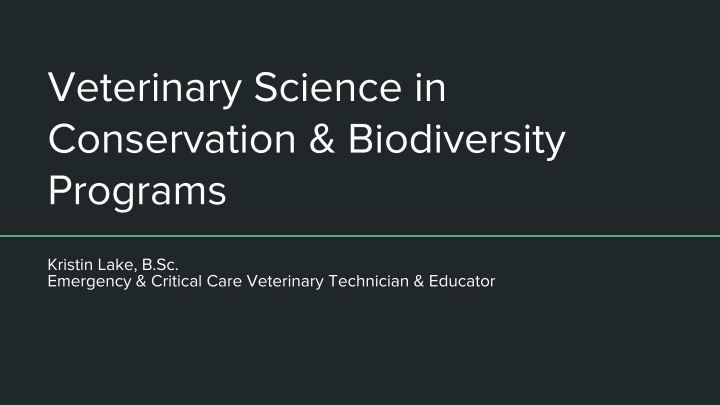
Conservation Biodiversity Programs and Wildlife Veterinary Science Overview
Explore the world of biodiversity and conservation in veterinary science. Learn about the importance of protecting Earth's natural resources and wildlife species. Discover tactics used in game reserves and oceans to safeguard biodiversity. Meet experts in the field and discover how to become a wildlife veterinarian/nurse.
Download Presentation

Please find below an Image/Link to download the presentation.
The content on the website is provided AS IS for your information and personal use only. It may not be sold, licensed, or shared on other websites without obtaining consent from the author. If you encounter any issues during the download, it is possible that the publisher has removed the file from their server.
You are allowed to download the files provided on this website for personal or commercial use, subject to the condition that they are used lawfully. All files are the property of their respective owners.
The content on the website is provided AS IS for your information and personal use only. It may not be sold, licensed, or shared on other websites without obtaining consent from the author.
E N D
Presentation Transcript
Veterinary Science in Conservation & Biodiversity Programs Kristin Lake, B.Sc. Emergency & Critical Care Veterinary Technician & Educator
Overview What is Biodiversity? What is Conservation? Types of Biodiversity/Conservation Tactics Utilized on Game Reserves Types of Biodiversity/Conservation Tactics Utilized in the Ocean Tracking Wildlife Ethics in Conservation How Do You Become an African Wildlife Veterinarian/Nurse? Meet Anne Lindsay, LVT, CVPP, CCRP, CCMT, FFCP, OACM, VTS (Clinical Practice - Canine/Feline), and Future African Wildlife Veterinarian Question & Answer Portion
What is Biodiversity? Biodiversity refers to the variety of living species on Earth, including plants, animals, bacteria, and fungi. While Earth s biodiversity is so rich that many species have yet to be discovered, many species are being threatened with extinction due to human activities, putting the Earth s magnificent biodiversity at risk.
What is Conservation? Conservation is the act of protecting Earth s natural resources for current and future generations.
Types of Biodiversity/Conservation Tactics Utilized on Game Reserves 1. 2. Habitat Restoration 3. Sustainable Use of Natural Resources 4. Captive Breeding & Reintroduction 5. Education & Awareness Protected Areas
Types of Biodiversity/Conservation Tactics Utilized on Game Reserves 1. Protected Areas Protected areas are one of the most effective conservation strategies for biodiversity. These areas are designated for the conservation of natural and cultural resources and are managed to ensure their long-term protection. Protected areas can range from small nature reserves to large national parks, and they play a crucial role in conserving biodiversity by providing habitat for endangered species, maintaining ecosystem processes, and preserving cultural heritage.
Types of Biodiversity/Conservation Tactics Utilized on Game Reserves 2. Habitat Restoration Habitat restoration is another effective conservation strategy for biodiversity. This strategy involves restoring degraded or destroyed habitats to their natural state. Habitat restoration can include activities such as reforestation, wetland restoration, and coral reef restoration. By restoring habitats, we can provide suitable conditions for endangered species to thrive and help maintain ecosystem processes.
Types of Biodiversity/Conservation Tactics Utilized on Game Reserves 3. Sustainable Use of Natural Resources The sustainable use of natural resources is a conservation strategy that aims to balance human needs with the needs of the environment. This strategy involves using natural resources in a way that meets our needs without compromising the ability of ecosystems to function properly. Examples of sustainable use of natural resources include sustainable forestry, sustainable fishing, and sustainable agriculture. By using natural resources sustainably, we can reduce our impact on biodiversity and ensure its long-term survival.
Types of Biodiversity/Conservation Tactics Utilized on Game Reserves 4. Captive Breeding and Reintroduction Captive breeding and reintroduction programs are conservation strategies that aim to increase the population of endangered species. This strategy involves breeding endangered species in captivity and releasing them back into the wild. Captive breeding and reintroduction programs can be highly effective in increasing the population of endangered species, but they can also be expensive and time-consuming.
Types of Biodiversity/Conservation Tactics Utilized on Game Reserves 5. Education and Awareness Education and awareness are essential conservation strategies for biodiversity. This strategy involves educating people about the importance of biodiversity and the threats it faces. By raising awareness, we can encourage people to take action to protect biodiversity and reduce their impact on the environment. Education and awareness can be achieved through a variety of methods, including public outreach, school programs, and media campaigns.
Types of Biodiversity/Conservation Tactics Utilized in the Ocean Traditionally, marine conservation efforts focus primarily on threatened species. On most governance levels, programs exist to determine the conservation status of such species at regional, national, and global scales. Often, an independent scientific advisory branch, such as the IUCN, assesses species current states, threats, and trends, and makes recommendations to a government branch, which is responsible for legal protection and associated management plans. These initiatives generally aim to protect all threatened species to avoid extinction or further degradation in efforts to keep all the parts. They also often track changes over time to upgrade or downgrade a species status and to identify intensifying or new threats requiring attention.
Types of Biodiversity/Conservation Tactics Utilized in the Ocean The collected data provides useful information concerning shark habits, distribution, conservation status, migratory patterns, and breeding. Utilization of these satellite geolocation transponders are not limited to sharks in the ocean and are used in conservation management for many species.
Ethics in Conservation Do we treat injured wildlife, leave them be or euthanize them? The main reasons for vets to treat wildlife is when they are injured by man-made tools (snares, gunshots, etc) or there is a public health concern (i.e. zoonotic diseases - diseases which can spread from an animal to a human). However, when animals are injured by another animal (whether it be by the same species or not) or if there is a contagion spreading amongst a species (i.e. distemper in painted dogs) then it becomes a more difficult decision whether to treat or not, especially if it is an endangered animal.
Ethics in Conservation Do we treat injured wildlife, leave them be or euthanize them? By treating and saving an animal you can potentially disrupt the natural order of life for these animals, their prey and their competitors. Or, for example, if you have the intention of treating it, but it dies during the capture and immobilization process, you cannot just leave it there for intentional or opportunistic predators to feed off of because the drugs that injected into an animal by darting them to immobilize them, are very dangerous to other animals if they were to consume that animal. So you have to take into account not just the welfare of that particular animal, but also how its life can potentially affect the niche it lives in. There are incredible ethical considerations and effects that a layperson doesn't typically think about. The only guideline you have is the hippocratic oath that every vet and nurse has taken.
Ethics in Conservation WHO KNOWS WHAT THE HIPPOCRATIC OATH IS IN MEDICINE? I swear by Apollo the physician, and Aesculapius the surgeon, likewise Hygeia and Panacea, and call all the gods and goddesses to witness, that I will observe and keep this underwritten oath, to the utmost of my power and judgment. I will reverence my master who taught me the art. Equally with my parents, will I allow him things necessary for his support, and will consider his sons as brothers. I will teach them my art without reward or agreement; and I will impart all my acquirement, instructions, and whatever I know, to my master s children, as to my own; and likewise to all my pupils, who shall bind and tie themselves by a professional oath, but to none else. With regard to healing the sick, I will devise and order for them the best diet, according to my judgment and means; and I will take care that they suffer no hurt or damage. Nor shall any man s entreaty prevail upon me to administer poison to anyone; neither will I counsel any man to do so. Moreover, I will give no sort of medicine to any pregnant woman, with a view to destroy the child. Further, I will comport myself and use my knowledge in a godly manner. I will not cut for the stone,but will commit that affair entirely to the surgeons. Whatsoever house I may enter, my visit shall be for the convenience and advantage of the patient; and I will willingly refrain from doing any injury or wrong from falsehood, and (in an especial manner) from acts of an amorous nature, whatever may be the rank of those who it may be my duty to cure, whether mistress or servant, bond or free. Whatever, in the course of my practice, I may see or hear (even when not invited), whatever I may happen to obtain knowledge of, if it be not proper to repeat it, I will keep sacred and secret within my own breast. If I faithfully observe this oath, may I thrive and prosper in my fortune and profession, and live in the estimation of posterity; or on breach thereof, may the reverse be my fate! ALL DOCTORS AND NURSES SWEAR BY THIS OATH
How Do You Become an African Wildlife Veterinarian/Nurse? Becoming an African wildlife vet or nurse is difficult because of the industry; there are not many open positions, especially for veterinary nurses (not much need for wildlife vet nurse). But if you are serious about entering this special sub-field of veterinary medicine you must stay motivated and passionate about it because luck and timing have a big part to play in it. As a stateside veterinary nurse you'll need to save money and set aside time-off to volunteer and/or intern in Africa in order to obtain the experience, knowledge and skill set needed to work in the field. You'll also need to submit certain documents pertaining to your veterinary technician accreditation and certification/licensure to the Veterinary Council of your specified African country in order to register for their veterinary nursing exam to receive your certification to legally practice.
Meet Anne Lindsay, LVT, CVPP, CCRP, CCMT, FFCP, OACM, VTS (Clinical Practice - Canine/Feline), and Future African Wildlife Veterinarian Anne Lindsay is an American-born Licensed Veterinary Technician and Veterinary Technician Specialist who has volunteered her time and dedication to conservation and biodiversity causes on the African continent for several years. She was recently accepted to Veterinary School in Kenya where she will concentrate her studies and focus on treating African wildlife once she becomes a Doctor of Veterinary Medicine. She starts her Veterinary School journey this fall!
Meet Anne Lindsay, LVT, CVPP, CCRP, CCMT, FFCP, OACM, VTS (Clinical Practice - Canine/Feline), and Future African Wildlife Veterinarian video000000.MP4 Anne drawing blood from the jugular vein in the neck of a sedated wild African hyena
Meet Anne Lindsay, LVT, CVPP, CCRP, CCMT, FFCP, OACM, VTS (Clinical Practice - Canine/Feline), and Future African Wildlife Veterinarian video000000.MP4 Anne recovering a sedated wild African elephant
Meet Anne Lindsay, LVT, CVPP, CCRP, CCMT, FFCP, OACM, VTS (Clinical Practice - Canine/Feline), and Future African Wildlife Veterinarian video000000.MP4 Anne monitoring the sedation depth and vital signs of a wild African zebra
Question & Answer Portion DOES ANYONE HAVE ANY QUESTIONS? THANK YOU ALL FOR YOUR ATTENTION TODAY! I HOPE YOU ENJOYED THIS LECTURE AND PURSUE CAREERS IN VETERINARY MEDICINE AND SCIENCE!
Resources https://education.nationalgeographic.org/resource/biodiversity/ https://nbs.net/a-simple-and-visual-definition-of-biodiversity/ https://education.nationalgeographic.org/resource/conservation-encyclopedic/ https://www.rolcruise.co.uk/blog/wildlife-conservation-projects-around-the-world https://fastercapital.com/topics/conservation-strategies-for-biodiversity.html https://www.sciencedirect.com/science/article/pii/S0960982221009131 https://www.oceans-research.com/what-is-shark-tagging-and-why-is-it-important/ https://mccolloughscholars.as.ua.edu/hippocratic-oath- classic/#:~:text=With%20regard%20to%20healing%20the,any%20man%20to%20do%20so. Contributor Credit: All photos/videos and references to African Wildlife Ethics, Veterinarians & Veterinary Nurses are property of Anne Lindsay


